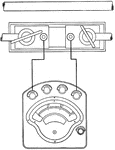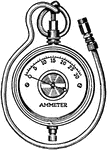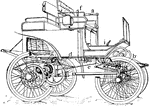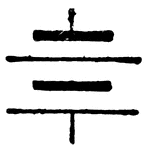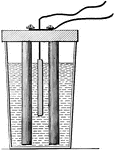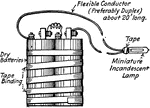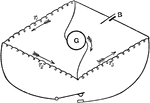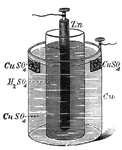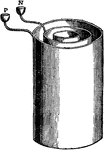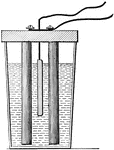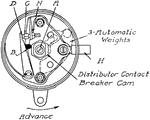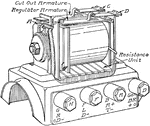Clipart tagged: ‘battery’

Arc lamp
"In all the arc lamps in common use, the coil, by means of which the automatic maintenance of the arc…

Battery
"The term battery is applied either to a single jar, or cell, containing the generating materials, or…

Battery Resistance
An illustration of the assisting and opposing method used to measure battery resistance.

Galvanic Battery
"Galvanism is the branch of electric science to which an experiment by Galvani gave birth. His wife,…

Galvanic Battery
"If we take for example, a slip of zinc, and another of copper, and place the in a cup of diluted sulphuric…

Primary Battery
Battery which is not intended to be recharged and is discarded when it has delivered all of its electrical…
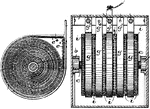
Storage Battery
A rechargeable battery also known as a storage battery is a group of one or more secondary cells. Rechargeable…

Trough Battery
The trough battery was a variant of the Voltaic Pile and was invented by William Cruickshank c1800.…

Wallaston's Battery
In Wollaston's battery, the wooden box was replaced with an earthenware vessel, and a copper plate was…

Wallaston's Battery
In Wollaston's battery, the wooden box was replaced with an earthenware vessel, and a copper plate was…

Voltaic cell
"Just as a head of water supplies a hydraulic pressure that causes the liquid to flow through a pipe…

Confederate Batteries
"Fredericksburg, Va., and the Confederate batteries and pickets, as seen from Falmouth Heights, headquarters…
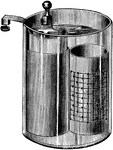
Daniel Cell
The first two-fluid cell was incented by Daniell, and English electrician in 1836..." -Atkinson 1903

Edison-Lalande Cell
"...is constructed with a plate of black oxide of copper suspended between two plates of zinc, and the…

Ruins of Battery at Fort McHenry
Fort McHenry, in Baltimore, Maryland, is a star shaped fort best known for its role in the War of 1812…
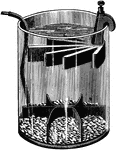
Gravity Cell
"The electric resistance of the porous cup employed in the Daniel cell, and the local action produced…

High-Tension Ignition System
Diagram of a high-tension ignition system. A is the source of current, usually a batter in earlier days,…

Ignition System
Diagram of a low-tension ignition system. A is the battery, B is a spark coil, and C, D, and E are the…

Jump start ignition
"Diagram of battery and coil connections for jump spark iginition as applied to a motor cycle." —…
!["...or in a number of [leyden] jars connected together as a Leyden battery." -Atkinson 1903](https://etc.usf.edu/clipart/35700/35716/leybatt_35716_mth.gif)
Leyden Battery
"...or in a number of [leyden] jars connected together as a Leyden battery." -Atkinson 1903

Magnetic Telegraph
"Morse magnetic telegraph will be understood by reference to the accompanying diagram, which represents…

Mortar Battery
An illustration of a mortar battery located at the Brooklyn Navy Yard. A mortar is a muzzleloading indirect…

Electric Battery Operated Motor
An electric motor is a motor that uses electrical energy to produce mechanical energy, usually through…
Parallel Connection
"Diagram of a multiple or parallel connection. When connected in this manner the voltage of the battery…

Parallel Connection
Figure showing battery cells connected in parallel, with all of the positive ends wired together, and…

Series Connection
Figure showing a series type of connection between multiple battery cells, where the negative end of…

Series Multiple Connection
"Diagram of a series multiple connction. Two sets of cells are connected in series, and the two batteries…

Swamp Angel
One of the most famous Parrott rifles is the Swamp Angel, an 8-inch (200 mm) gun used by federal Brigadier…
Volta's Crown of Cups
"The metallic elements C and Z each conssted of two metals, the plate C being of copper and the plate…
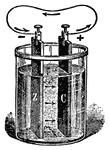
Voltaic Cell
The Voltaic Cell is also known as the Galvanic Battery. Luigi Galvani discovered it. It is a combination…
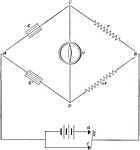
Wheatstone Bridge in Circuit
"The Wheatstone bridge is used as a way to measure resistance of a unknown resitors." -Avery 1895
